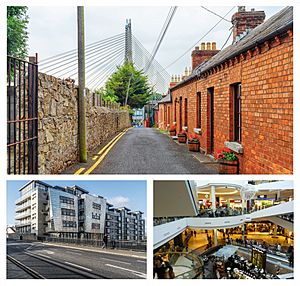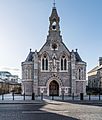Dundrum, Dublin facts for kids
Quick facts for kids
Dundrum
Dún Droma
|
|
|---|---|
|
Suburb
|
|

Clockwise from top: William Dargan Bridge as seen from Victoria Terrace; the interior of Dundrum Town Centre; "The Laurels" apartment complex in central Dundrum
|
|
| Country | Ireland |
| Province | Leinster |
| County | Dún Laoghaire–Rathdown |
| Time zone | UTC±0 (WET) |
| • Summer (DST) | UTC+1 (IST) |
| Eircode routing key |
D14, D16
|
| Telephone area code | +353(0)1 |
Dundrum (which means "the ridge fort" in Irish) used to be a small village. Now, it's a busy outer suburb of Dublin, Ireland. You can find it in the postal districts of Dublin 14 and Dublin 16. Dundrum is famous for the Dundrum Town Centre, which is the biggest shopping centre in Ireland!
Contents
History of Dundrum
Early Beginnings
One of the oldest mentions of Dundrum is about the first St. Nahi's Church. This church was built in the 8th century. Today, an 18th-century church stands in its place. The old name for Dundrum was "Taney". This name comes from Tigh Naithi, meaning "the house or place of Nath Í".
Scientists have dug near the church and found old walls from the 6th century. They even found a nearly whole jug from the 1200s!
The name "Taney" first appeared in a document in 1178. It was in a special letter from St. Laurence O'Toole to Christchurch.
Castles and Old Life
When the Normans arrived in Ireland in 1169, they built many forts around Dublin. A castle was built in Dundrum around the 1200s as part of these defenses. Later, in 1590, a new castle was built by Richard Fitzwilliam. This castle was part of a line of forts protecting an area called the Pale (an area controlled by the English).
The original village grew around Dundrum Castle. It was a rural outpost that helped protect against attacks from Irish tribes like the O'Tooles. In 1619, the Fitzwilliam family was given the castle for their bravery. However, they were forced to leave in 1642. They came back for a short time but left for good in 1653. The family owned the land until 1790. The castle was never used again and is now a ruin. You can still see it overlooking the Dundrum bypass and the shopping centre.
When people dug at the castle in 1989, they found old pottery, oyster and cockle shells, and animal bones. They even found pottery from France, which was probably used to store wine!
Village Life and Industry
The Fitzwilliam family's arrival and the castle helped bring business to Dundrum. The village had "The Manor Mill," where corn was ground into flour. A nearby waterfall also powered a paper mill and an ironworks.
In 1813, the first Roman Catholic church, Holy Cross, was built on Main Street. It was replaced by a bigger church in 1878. This was when Dundrum became its own separate parish. A large addition was built in 1956. The church is made of Dublin granite, with special stone around the windows and doors.
In 1818, Christ Church (Church of Ireland) opened on Taney Road. It replaced an older, smaller church. People bought seats in the church to help pay for the new building. The architect for the new church was William Farrell.
In 1846, a Scottish writer named Thomas Carlyle visited Dundrum. He stayed with his friend Charles Gavan Duffy, who helped start the Young Ireland movement. Many other writers and speakers also joined them.
Growth and Changes
The village grew a lot after the Dublin and South Eastern Railway (DSER) arrived in 1854. By 1876, the Manor Mill became a laundry. It was the biggest employer of women in the area. The laundry's hooter (a loud horn) was a common sound. It would blow to signal the start and end of work.
In 1881, a builder named John Richardson built 26 small houses called the Pembroke Cottages. The Manor Mill Laundry bought six of these for its workers.
In 1893, a lawyer named Trevor Overend bought an old farmhouse. Today, this building is called Airfield House and is open to visitors.
The Dun Emer Press was started in Dundrum in 1903 by Elizabeth Yeats, with help from her famous brother, the poet William Butler Yeats.
In 1914, a Carnegie Library opened. It was first used for community events and even had a stage and kitchen. The building was also a school until the 1950s.
Modern Development
In 1971, Dundrum was one of the first places in Ireland to get a modern shopping centre. A much larger one, the Dundrum Town Centre, opened on March 3, 2005. It has one of the biggest cinemas in Ireland. There are plans to add hotels, apartments, and more shops to the old shopping centre area. However, these plans have been put on hold. The old centre is now called Dundrum Village Centre.
Amenities
In the village centre, you'll find the old shopping centre. It has a Lidl supermarket, a coffee shop, a furniture store, and a butcher's shop. Across the road, there's the Dundrum College of Further Education and the public library. The Dundrum Town Centre has many different shops and services.
Transport
Luas Tram Service
The Luas Green Line has two stops in Dundrum: Balally (which is near the shopping centre) and Dundrum. The tram line then goes over the large William Dargan Bridge at Taney Cross. This bridge is the biggest engineering structure on the line.
The Luas route mostly follows an old railway line. This line was used by the DSER from Dublin to Bray. It closed in 1958, but the path was kept clear. Later, the Luas took it over. Dundrum railway station opened in 1854 and closed in 1959.
There are plans for a new underground train system called Metrolink. It was suggested that it would stop at Dundrum's Luas stop. If built, MetroLink might replace the current Luas services on the Green Line. However, these plans are still being discussed.
Bus Services
Many bus routes serve Dundrum. They are run by Dublin Bus and Go-Ahead Ireland. Some routes include:
- Route 14 to Beaumont
- Route 44 (serving DCU)
- Route 44b (to Glencullen)
- Route 74 (Eden Quay to Dundrum)
- Route 116 (Parnell Square)
- Route 161 (Rockbrook)
- Route L25 (Dún Laoghaire to Dundrum)
- Route S6 (Blackrock to Tallaght)
There is also a private bus service, Dublin Coach, that goes to Dublin Airport. It stops at the Red Cow interchange.
People from Dundrum
Many interesting people have lived in or are from Dundrum:
- George Johnstone Stoney: A 19th-century Irish scientist who first suggested the idea of the electron (a tiny particle).
- Séamus Brennan: A former government minister.
- Stephen Roche: A famous cyclist who won the Tour de France.
- Charles Manners and Fanny Moody: Operatic singers who retired and passed away here.
- Annie Mac: A well-known DJ for Radio One.
- Derek Mooney: An RTÉ host.
- Brenda Fricker: An Oscar-winning actress.
- Eavan Boland: A poet whose poems often describe the area.
- Eamon Ryan: A former leader of the Green Party.
- Violet Spiller Hay: A notable Christian Scientist.
- Liz Roche: A choreographer.
Sport
Dundrum is home to some sports clubs and famous athletes:
- Cyclist Stephen Roche, who won the Tour de France, is from Dundrum. His son, Nicolas Roche, is also a cyclist.
- Dundrum has an athletics club called Dundrum Athletic.
- There is a football (soccer) team called Dundrum Athletic F.C..
- The local GAA club is Naomh Olaf.
Images for kids
-
The original Dundrum station built by William Dargan in 1854 behind the modern Luas stop.







